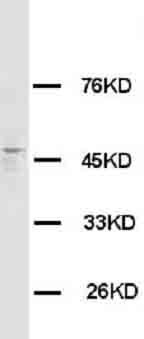Anti-HRH3 Antibody
- SPECIFICATION
- CITATIONS
- PROTOCOLS
- BACKGROUND

Application
| WB |
|---|---|
| Primary Accession | Q9Y5N1 |
| Host | Rabbit |
| Reactivity | Human, Mouse, Rat |
| Clonality | Polyclonal |
| Format | Lyophilized |
| Description | Rabbit IgG polyclonal antibody for Histamine H3 receptor(HRH3) detection. Tested with WB in Human;Mouse;Rat. |
| Reconstitution | Add 0.2ml of distilled water will yield a concentration of 500ug/ml. |
| Gene ID | 11255 |
|---|---|
| Other Names | Histamine H3 receptor, H3R, HH3R, G-protein coupled receptor 97, HRH3, GPCR97 |
| Calculated MW | 48671 MW KDa |
| Application Details | Western blot, 0.1-0.5 µg/ml, Human, Rat, Mouse |
| Subcellular Localization | Cell membrane; Multi-pass membrane protein. |
| Tissue Specificity | Expressed predominantly in the CNS, with the greatest expression in the thalamus and caudate nucleus. The various isoforms are mainly coexpressed in brain, but their relative expression level varies in a region-specific manner. Isoform 3 and isoform 7 are highly expressed in the thalamus, caudate nucleus and cerebellum while isoform 5 and isoform 6 show a poor expression. Isoform 5 and isoform 6 show a high expression in the amygdala, substantia nigra, cerebral cortex and hypothalamus. Isoform 7 is not found in hypothalamus or substantia nigra. |
| Protein Name | Histamine H3 receptor(H3R/HH3R) |
| Contents | Each vial contains 5mg BSA, 0.9mg NaCl, 0.2mg Na2HPO4, 0.05mg Thimerosal, 0.05mg NaN3. |
| Immunogen | A synthetic peptide corresponding to a sequence at the C-terminus of human HRH3(428-445aa CPQKLKIQPHSSLEHCWK), different from the related rat sequence by three amino acids. |
| Purification | Immunogen affinity purified. |
| Cross Reactivity | No cross reactivity with other proteins |
| Storage | At -20˚C for one year. After r˚Constitution, at 4˚C for one month. It˚Can also be aliquotted and stored frozen at -20˚C for a longer time.Avoid repeated freezing and thawing. |
| Name | HRH3 |
|---|---|
| Synonyms | GPCR97 |
| Function | The H3 subclass of histamine receptors could mediate the histamine signals in CNS and peripheral nervous system. Signals through the inhibition of adenylate cyclase and displays high constitutive activity (spontaneous activity in the absence of agonist). Agonist stimulation of isoform 3 neither modified adenylate cyclase activity nor induced intracellular calcium mobilization. |
| Cellular Location | Cell membrane; Multi-pass membrane protein. |
| Tissue Location | Expressed predominantly in the CNS, with the greatest expression in the thalamus and caudate nucleus. The various isoforms are mainly coexpressed in brain, but their relative expression level varies in a region-specific manner. Isoform 3 and isoform 7 are highly expressed in the thalamus, caudate nucleus and cerebellum while isoform 5 and isoform 6 show a poor expression. Isoform 5 and isoform 6 show a high expression in the amygdala, substantia nigra, cerebral cortex and hypothalamus. Isoform 7 is not found in hypothalamus or substantia nigra |

Thousands of laboratories across the world have published research that depended on the performance of antibodies from Abcepta to advance their research. Check out links to articles that cite our products in major peer-reviewed journals, organized by research category.
info@abcepta.com, and receive a free "I Love Antibodies" mug.
Provided below are standard protocols that you may find useful for product applications.
Background
The histamine receptor H3(HRH3) is a presynaptic autoreceptor on histamine neurons in the brain and a presynaptic heteroreceptor in nonhistamine-containing neurons in both the central and peripheral nervous systems. The deduced 445-amino acid HRH3 protein contains 7 predicted transmembrane domains. And it shares 22% and 21.4% amino acid sequence homology with the H1(HRH1) and H2(HRH2) receptors, respectively. The expression of recombinant HRH3 in a variety of cell lines conferred an ability to inhibit adenylate cyclase in response to histamine, but not to acetylcholine or any other biogenic amine. Additionally, HRH3 was most notably observed throughout the thalamus, the ventromedial hypothalamus, and the caudate nucleus. Strong expression was also seen in layers II, V, and VIb of the cerebral cortex, in the pyramidal layers of the hippocampus, and in olfactory tubercle.
If you have used an Abcepta product and would like to share how it has performed, please click on the "Submit Review" button and provide the requested information. Our staff will examine and post your review and contact you if needed.
If you have any additional inquiries please email technical services at tech@abcepta.com.













 Foundational characteristics of cancer include proliferation, angiogenesis, migration, evasion of apoptosis, and cellular immortality. Find key markers for these cellular processes and antibodies to detect them.
Foundational characteristics of cancer include proliferation, angiogenesis, migration, evasion of apoptosis, and cellular immortality. Find key markers for these cellular processes and antibodies to detect them. The SUMOplot™ Analysis Program predicts and scores sumoylation sites in your protein. SUMOylation is a post-translational modification involved in various cellular processes, such as nuclear-cytosolic transport, transcriptional regulation, apoptosis, protein stability, response to stress, and progression through the cell cycle.
The SUMOplot™ Analysis Program predicts and scores sumoylation sites in your protein. SUMOylation is a post-translational modification involved in various cellular processes, such as nuclear-cytosolic transport, transcriptional regulation, apoptosis, protein stability, response to stress, and progression through the cell cycle. The Autophagy Receptor Motif Plotter predicts and scores autophagy receptor binding sites in your protein. Identifying proteins connected to this pathway is critical to understanding the role of autophagy in physiological as well as pathological processes such as development, differentiation, neurodegenerative diseases, stress, infection, and cancer.
The Autophagy Receptor Motif Plotter predicts and scores autophagy receptor binding sites in your protein. Identifying proteins connected to this pathway is critical to understanding the role of autophagy in physiological as well as pathological processes such as development, differentiation, neurodegenerative diseases, stress, infection, and cancer.


